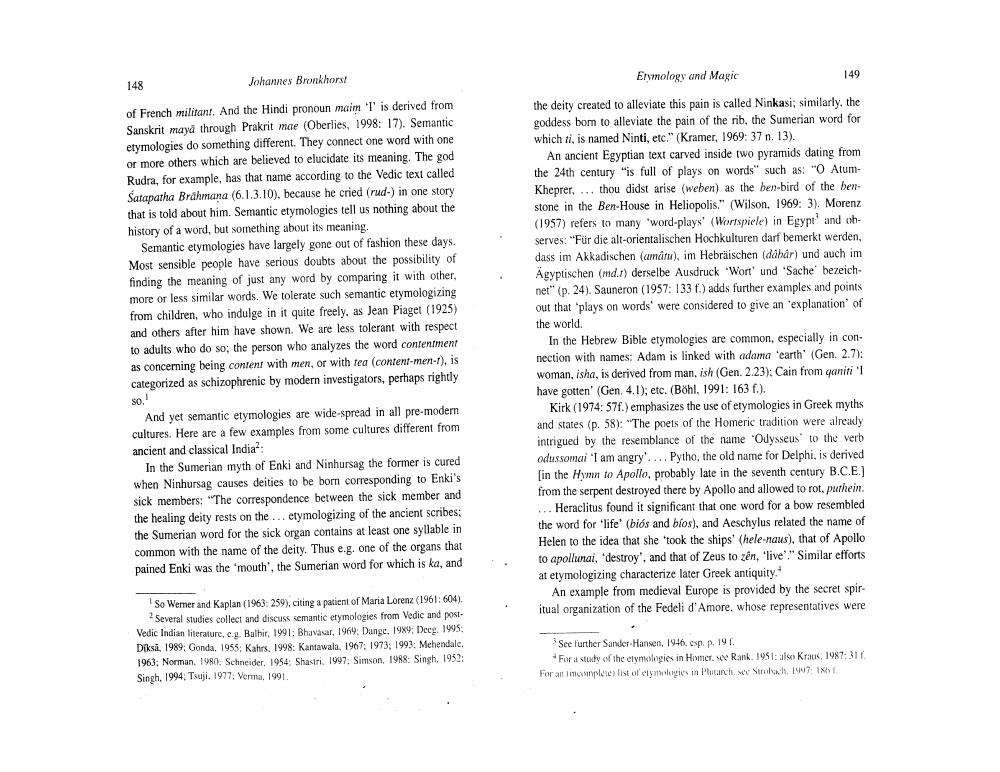Book Title: Etymology And Magic Yaskas Nirukta Flatos Cratylus And Riddle Of Semanticetymologies Author(s): Johannes Bronkhorst Publisher: Johannes Bronkhorst View full book textPage 2
________________ Etymology and Magic 149 148 Johannes Bronkhorst of French militant. And the Hindi pronoun maim 'T' is derived from Sanskrit mayd through Prakrit mae (Oberlies, 1998: 17). Semantic etymologies do something different. They connect one word with one or more others which are believed to elucidate its meaning. The god Rudra, for example, has that name according to the Vedic text called Satapatha Brahmana (6.1.3.10), because he cried (rud-) in one story that is told about him. Semantic etymologies tell us nothing about the history of a word, but something about its meaning. Semantic etymologies have largely gone out of fashion these days. Most sensible people have serious doubts about the possibility of finding the meaning of just any word by comparing it with other, more or less similar words. We tolerate such semantic etymologizing from children, who indulge in it quite freely, as Jean Piaget (1925) and others after him have shown. We are less tolerant with respect to adults who do so; the person who analyzes the word contentment as conceming being content with men, or with tea (content-men-t), is categorized as schizophrenic by modern investigators, perhaps rightly the deity created to alleviate this pain is called Ninkasi; similarly, the goddess bom to alleviate the pain of the rib, the Sumerian word for which ti, is named Ninti, etc." (Kramer, 1969:37 n. 13). An ancient Egyptian text carved inside two pyramids dating from the 24th century is full of plays on words such as: "O AtumKheprer,... thou didst arise (weben) as the ben-bird of the benstone in the Ben-House in Heliopolis." (Wilson, 1969: 3). Morenz (1957) refers to many 'word-plays' (Wortspiele) in Egypi' and onserves: "Für die alt-orientalischen Hochkulturen darf bemerkt werden, dass im Akkadischen (amatu), im Hebräischen (dabar) und auch im Agyptischen (md.r) derselbe Ausdruck 'Wort' und 'Sache bezeich net" (p. 24). Sauneron (1957: 133 f.) adds further examples and points out that plays on words' were considered to give an explanation of the world In the Hebrew Bible etymologies are common, especially in connection with names: Adam is linked with adama earth (Gen. 2.7): woman, isha, is derived from man, ish (Gen. 2.23); Cain from qaniti have gotten' (Gen. 4.1); etc. (Bohl, 1991: 163 f.). Kirk (1974: 57f.) emphasizes the use of etymologies in Greek myths and states (p. 58): "The poets of the Homeric tradition were already intrigued by the resemblance of the name 'Odysseus to the verb odussomai "I am angry.... Pytho, the old name for Delphi, is derived [in the Hyment to Apollo, probably late in the seventh century B.C.E.] from the serpent destroyed there by Apollo and allowed to rot, puthein. ... Heraclitus found it significant that one word for a bow resembled the word for 'life (biós and bios), and Aeschylus related the name of Helen to the idea that she took the ships' (hele naus), that of Apollo to apollunai, 'destroy, and that of Zeus to zen, 'live'." Similar efforts at etymologizing characterize later Greek antiquity An example from medieval Europe is provided by the secret spiritual organization of the Fedeli d'Amore, whose representatives were 80, And yet semantic etymologies are wide-spread in all pre-modem cultures. Here are a few examples from some cultures different from ancient and classical India : In the Sumerian myth of Enki and Ninhursag the former is cured when Ninhursag causes deities to be born corresponding to Enki's sick members: "The correspondence between the sick member and the healing deity rests on the ... etymologizing of the ancient scribes: the Sumerian word for the sick organ contains at least one syllable in common with the name of the deity. Thus e.g. one of the organs that pained Enki was the mouth', the Sumerian word for which is ka, and So Werner and Kaplan (1963: 259), citing a patient of Maria Lorenz (1961: 604). Several studies collect and discuss semantic etymologies from Vedic and postVedic Indian literaturc, c.g. Balbir, 1991: Bhavadar, 1969: Dange. 1989; Deeg. 1995: Diksi. 1989. Gonda. 1955: Kahrs. 1998: Kantawala. 1967 1963: Norman. 1980. Schneider, 1954: Shastri 1997, Simson, 1988: Singh, 1952: Singh. 1994. Tsuji. 1977: Verma. 1991. See further Sander Hansen, 1946. pp191 For a study of the eynologies in Himmersee Rank. 1951: For all implete list of clymogies in Parch. S Kraus, 1987: 311. IPage Navigation
1 2 3 4 5 6 7 8 9 10 11 12 13 14 15 16 17 18 19 20 21 22 ... 29
